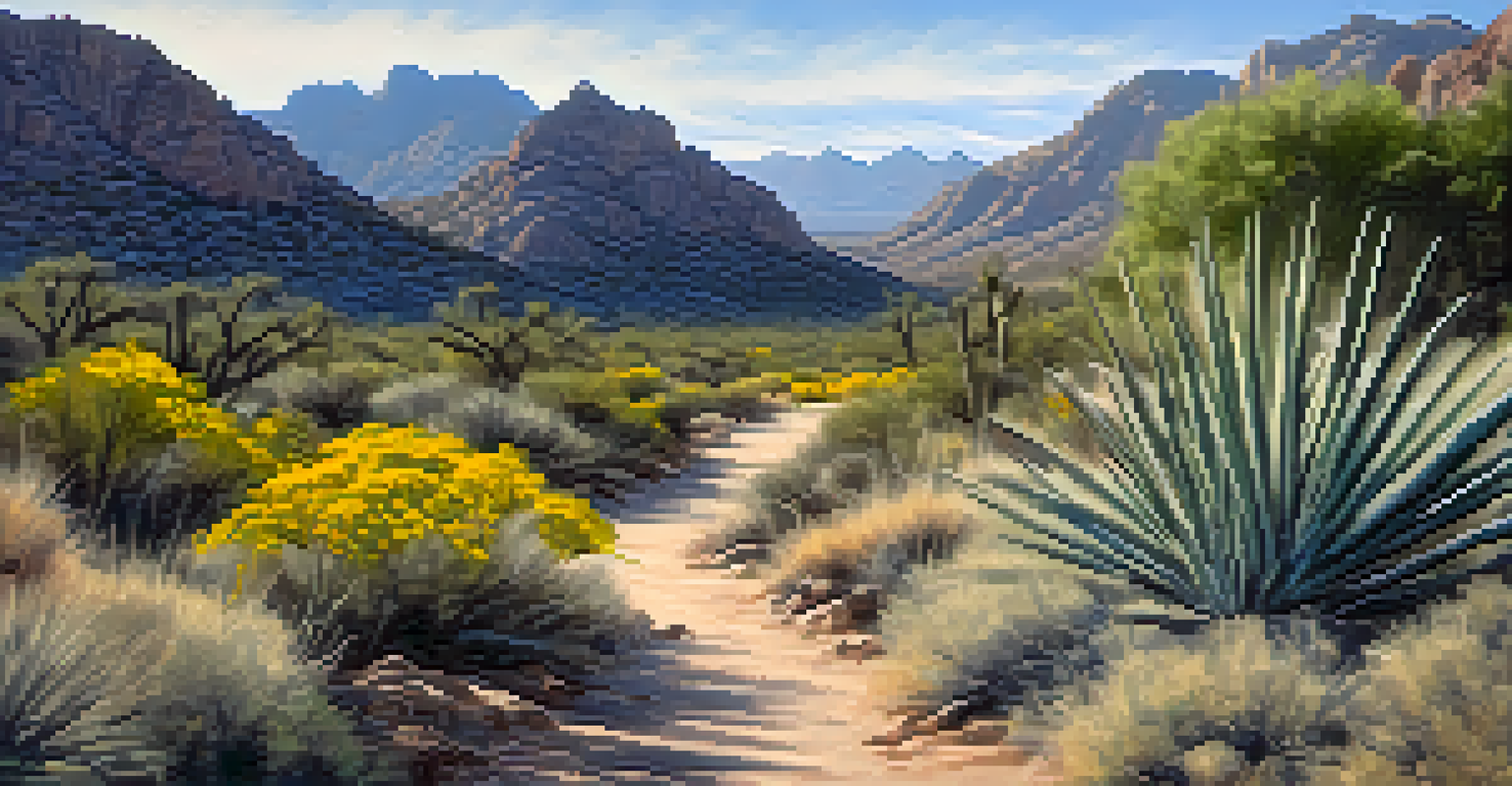Birdwatching in Tucson: Parks That Attract Unique Species

Why Tucson is a Birdwatcher's Paradise
Tucson, located in the Sonoran Desert, is a haven for birdwatchers. Its diverse ecosystems range from desert landscapes to lush riparian areas, attracting a wide variety of bird species. With over 500 species recorded in the region, enthusiasts can witness everything from vibrant hummingbirds to majestic hawks.
In every walk with nature one receives far more than he seeks.
The unique geography and climate of Tucson create ideal conditions for both migratory and resident birds. The city sits at a crossroads of different avian habitats, making it a significant stopover for many migrating species. This combination of factors makes Tucson an essential location for both novice and seasoned birdwatchers alike.
Related Resource
Whether you're peering through binoculars in a local park or hiking in the surrounding mountains, Tucson’s birdwatching opportunities are abundant. The rich variety of species and the stunning natural beauty create an unforgettable experience that keeps birdwatchers coming back for more.
Saguaro National Park: Iconic Birds and Cacti
Saguaro National Park is a must-visit for birdwatching in Tucson. This park, famous for its towering saguaro cacti, provides a unique habitat for many birds. From the elusive Gila Woodpecker to the colorful Gambel's Quail, the park offers a variety of species to observe.

While exploring the park's trails, visitors might also spot the majestic Red-tailed Hawk soaring above. The combination of desert flora and fauna creates a vibrant ecosystem that attracts both birds and birdwatchers. Early mornings are particularly rewarding, as the birds are most active during this time.
Diverse Habitats for Birdwatching
Tucson's unique ecosystems offer a rich variety of bird species, attracting both novice and seasoned birdwatchers.
Additionally, the park hosts special birdwatching programs and guided tours, making it accessible for those new to the hobby. Engaging with knowledgeable guides can enhance your experience, providing insights into bird behaviors and the importance of conservation.
Rio Vista Natural Resource Park: A Hidden Gem
Rio Vista Natural Resource Park is often overlooked but is a prime spot for birdwatching. Nestled along the Rillito River, this park features lush vegetation that attracts a diverse range of birds. Birdwatchers can enjoy sightings of species like the Black Phoebe and the Great Egret as they hunt for fish in the water.
Birdwatching is not about the birds; it’s about the experience of being in nature.
The park’s walking trails and picnic areas provide excellent vantage points for observing birds. Visitors can take their time to enjoy the peaceful surroundings while keeping an eye out for feathered friends. The serene environment also makes it a great place for a family outing.
Related Resource
In addition to birdwatching, Rio Vista offers opportunities for photography and nature walks. The combination of wildlife and beautiful scenery creates a perfect backdrop for capturing memorable moments, making it a favorite for both bird lovers and photographers.
Sweetwater Wetlands: A Birdwatching Hotspot
Sweetwater Wetlands is renowned for its rich biodiversity and is a top destination for birdwatching. This urban oasis is home to numerous waterfowl and shorebirds, making it ideal for spotting rare species. Birdwatchers can expect to see everything from American Avocets to various types of ducks.
The wetlands are designed with trails and viewing platforms that allow for easy observation of birds in their natural habitat. The tranquility of the area enhances the experience, as you can enjoy the sounds of chirping birds while immersing yourself in nature. Early mornings and late afternoons are the best times to visit for optimal bird activity.
Top Birdwatching Locations
Saguaro National Park and Sweetwater Wetlands are just two of the prime spots in Tucson where bird enthusiasts can observe a wide array of birds.
Moreover, the Sweetwater Wetlands regularly hosts educational programs that focus on bird conservation. These initiatives not only provide valuable information but also foster a greater appreciation for the importance of protecting these habitats.
Tucson Mountain Park: Diverse Habitats and Species
Tucson Mountain Park offers a stunning backdrop for birdwatching, with its varied habitats ranging from desert scrub to riparian zones. This diversity makes it home to a wide array of bird species, including the striking Curve-billed Thrasher. The park’s expansive trails provide ample opportunities to explore and observe.
As you hike through the park, keep an eye out for the mesmerizing flight of the Golden Eagle. The elevation changes throughout the park allow for different birdwatching experiences, whether you're at lower elevations or hiking up to a lookout point. Each area has its own unique birdlife waiting to be discovered.
Related Resource
Additionally, Tucson Mountain Park is a great spot for families to engage in outdoor activities. With ample picnic areas and scenic views, it’s a perfect place to spend a day enjoying nature while keeping an eye out for the local bird population.
Pima County Fairgrounds: Urban Birdwatching
The Pima County Fairgrounds may not be the first location that comes to mind for birdwatching, but it offers surprising opportunities. This urban setting attracts a variety of birds, particularly during migration seasons. Birdwatchers can spot species such as the Lesser Goldfinch and the House Finch flitting around the grounds.
The fairgrounds’ open spaces are ideal for observing birds in flight, especially during events when food scraps attract various species. It’s a unique blend of urban life and nature, demonstrating how diverse bird habitats can be even in a city setting.
Essential Birdwatching Tips
To enhance your birdwatching experience, bring binoculars, visit during peak activity times, and respect wildlife habitats.
Visiting during special events can also lead to unexpected bird sightings, making it an exciting place for casual birdwatchers. So next time you’re at the fairgrounds, don’t forget to bring your binoculars for a chance encounter with local avian residents.
Catalina State Park: Scenic Views and Birdwatching
Catalina State Park, nestled at the base of the Santa Catalina Mountains, is a haven for birdwatchers seeking breathtaking views. The park's diverse landscapes host a rich variety of birds, including the elegant Black-throated Sparrow and the striking Western Bluebird. With numerous trails to explore, every hike can lead to new birdwatching adventures.
The park's combination of desert, riparian, and mountain environments creates an ideal setting for spotting different species. Whether you’re hiking along the trails or enjoying a picnic, the sounds of chirping birds add to the experience. Early morning hikes are particularly rewarding, as the birds are most active at this time.

In addition to birdwatching, Catalina State Park offers stunning vistas and opportunities for other outdoor activities. The park’s beauty and tranquility make it a perfect escape from the hustle and bustle of city life, allowing you to connect with nature and observe its wildlife.
Tips for Birdwatching in Tucson
To make the most of your birdwatching experience in Tucson, consider a few helpful tips. First, bring a pair of binoculars for better observation of distant birds. A field guide or a bird identification app can also enhance your experience by helping you recognize different species.
Timing is crucial; early mornings and late afternoons are when birds are most active. Dress appropriately for the weather, and don’t forget to bring water and snacks for longer excursions. Patience is key—sometimes, the best sightings happen when you least expect them.
Lastly, respect the natural environment and the birds’ habitats. Keep a safe distance and avoid disturbing nesting sites. By being a responsible birdwatcher, you contribute to the conservation of these beautiful species and their environments, ensuring that Tucson remains a birdwatching paradise for years to come.